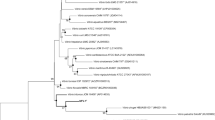Abstract
The growth rates of 30 different strains ofVibrio parahaemolyticus andVibrio alginolyticus at 37°C was determined. Each species consists of two major groups, one having a short generation time (12–14 min) and one with a longer generation time (20–25 min). The diversity in generation times of different strains belonging to the same species is discussed. The effect of temperature, salt, and nutrient concentrations on the growth rate of oneV. alginolyticus strain (NCMB 1803) was studied. The most striking is the effect of the temperature; at 39°C the generation time is 10–11 min, while at 21°C it is 60 min. The heat of activation for growth calculating from such data is 22,580 kcal/mole/hr−1. The ecological significance of these results is discussed.
Similar content being viewed by others
References
Bartley, C. H., and Slanetz, L. W. 1971. Occurrence ofVibrio parahaemolyticus in estuarine waters and oysters of New Hampshire.Appl. Microbiol. 21: 965–966.
Baross, J., and Liston, J. 1970. Occurrence ofVibrio parahaemolyticus and related hemolytic strains in marine environments of Washington State.Appl. Microbiol. 20: 179–186.
Brock, T. D. (1967). Life at high temperatures.Science 158: 1012–1019.
Eagon, R. G. 1962.Pseudomonas natregenis a marine bacterium with a generation time of less than ten minutes.J. Bacteriol. 82: 736–737.
Horie, S. M., Kuzumi, O., and Kato, N. 1966. Comparative observation on the range of growth temperature among three biotypes ofVibrio parahaemolyticus.Bull. Jap. Soc. Sci. Fish. 32: 424–426 (in Japanese).
Ingraham, J. L., and Stokes, J. L. 1959. Psychrophilic bacteria.Bacteriol. Rev. 23: 97–108.
Kaneko, T., and Colwell, R. A. 1973. Ecology ofVibrio parahaemolyticus in Chesapeake Bay.J. Bacteriol. 113: 24–32.
Katoh, H. 1965. Studied on the growth rate of various food bacteria. I. On the generation time ofVibrio parahaemolyticus Fujino.Jap. J. Bacteriol. 20: 94–100 (in Japanese).
Katoh, H. 1965. Studied on the growth rate of various food bacteria. III. The growth ofVibrio parahaemolyticus in raw fish meat.Jap. J. Bacteriol. 20: 541–544. (in Japanese).
Sakazaki, R. 1967. Isolation and identification ofVibrio parahaemolyticus. p. 119–137.In:Vibrio parahaemolyticus. T. Fujino and H. Fumumi, editors. Nayashoten, Tokyo, Japan (in Japanese).
Sakazaki, R. 1968. Proposal ofVibrio alginolyticus for the biotype ofVibrio parahaemolyticus.Jap. J. Med. Sci. Biol. 27: 359–362 (in Japanese).
Vacelet, Mme. E. 1972. Des temps de gèneràtion de l'ardre de la minute pour des bactèries marines.C. R. Acad. Sci. Paris 274: 2083–2085.
Author information
Authors and Affiliations
Rights and permissions
About this article
Cite this article
Ulitzur, S. Vibrio parahaemolyticus andVibrio alginolyticus: Short generation-time marine bacteria. Microb Ecol 1, 127–135 (1974). https://doi.org/10.1007/BF02512384
Issue Date:
DOI: https://doi.org/10.1007/BF02512384




